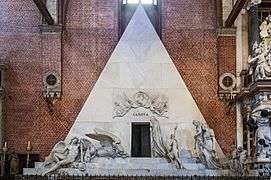Santa Maria Gloriosa dei Frari

_-_Main_altar.jpg)
_-_Chapter_Room_-_Hagar_in_the_Desert_by_Giovanni_Battista_Pittoni.jpg)
_-_Coro_dei_Frati.jpg)
The Basilica di Santa Maria Gloriosa dei Frari, usually just called the Frari, is a church in Venice, northern Italy. One of the greatest churches in the city, it has the status of a minor basilica. It stands on the Campo dei Frari at the heart of the San Polo district. The church is dedicated to the Assumption (Italian: Assunzione della Beata Vergine).
The Franciscans were granted land to build a church in 1250, but the building was not completed until 1338. Work almost immediately began on its much larger replacement, the current church, which took over a century to build. The campanile, the second tallest in the city after that of San Marco, was completed in 1396.
The imposing edifice is built of brick, and is one of the city's three notable churches built in the Italian Gothic style. As with many Venetian churches, the exterior is rather plain. The interior contains the only rood screen still in place in Venice.
The Frari is a parish church of the Vicariate of San Polo-Santa Croce-Dorsoduro. The other churches of the parish are San Barnaba, San Ludovico Vescovo, Santa Maria del Soccorso and Santa Margherita.
Titian, the most important member of the 16th-century Venetian school of painting, is interred in the Frari.
Works of art
- Giovanni Bellini, Madonna and Child with Ss. Nicholas of Bari, Peter, Mark and Benedict, the sacristy altarpiece
- Giambattista Pittoni, Hagar in the desert, Oil on Canvas, sacristy
- Bartolomeo Bon's workshop, figures of the Virgin and St. Francis on the west front
- Antonio and Paolo Bregno, tomb of Doge Francesco Foscari in the chancel (attributed; may actually be by Niccolò di Giovanni Fiorentino)
- Lorenzo Bregno
- tomb of Benedetto Pésaro above the sacristy door
- tomb of Alvise Pasqualino on the west wall
- Girolamo Campagna, statuettes of St. Anthony of Padua and St. Agnes on the water stoups in the nave
- Marco Cozzi, choir stalls in ritual choir
- Donatello, figure of St. John the Baptist in the first south choir chapel, Donatello's first documented work in Venice
- Tullio Lombardo, tomb of Pietro Bernardo on the west wall (attributed; may actually be by Giovanni Buora)
- Antonio Rizzo, tomb of Doge Niccolò Tron in the chancel
- Jacopo Sansovino, damaged figure of St. John the Baptist on the font in the Corner Chapel
- Titian
- Assumption, Large main altarpiece
- Pesaro Madonna on the north wall of the nave
- Paolo Veneziano, Doge Francesco Dandolo and His Wife Presented to the Virgin by Ss. Francis and Elizabeth in the sacristy
- Alessandro Vittoria
- figure of The Risen Christ on the west front
- figure of St. Jerome on the south wall of the nave
- Alvise Vivarini, St. Ambrose and other Saints in the north transept chapel, his last work
- Bartolomeo Vivarini
- St. Mark Enthroned in the Capella Corner in the north transept
- Madonna and Child with Saints, altarpiece in the third south choir chapel
Funerary monuments
- Francesco Barbaro (1390–1454) (humanist and senator)
- Pietro Bernardo (d. 1538) (senator)
- Antonio Canova (only his heart is buried here; the tomb, realised by his disciples, is based on the drawing of Canova himself for an unrealised tomb for Titian)
- Federico Corner
- Doge Francesco Dandolo (in the chapter house)
- Doge Francesco Foscari (d. 1457)
- Jacopo Marcello
- Claudio Monteverdi (one of the greatest composers of the 17th Century)
- Beato Pacifico (founder of the current church)
- Alvise Pasqualino (d. 1528) (Procurator of Venice)
- Benedetto Pésaro (d. 1503) (general)
- Doge Giovanni Pesaro
- Bishop Jacopo Pésaro (d. 1547)
- Paolo Savelli (condottiere) (the first Venetian monument to include an equestrian statue)
- Titian (d. 1576) (Renaissance painter)
- Melchiorre Trevisan (d. 1500) (general)
- Doge Niccolò Tron
 Monument to Antonio Canova
Monument to Antonio Canova_Cappella_dei_milanesi-_tomb_of_Claudio_Monteverdi.jpg) Tumb of Claudio Monteverdi
Tumb of Claudio Monteverdi_nave_left_-_Monument_to_Doge_Giovanni_Pesaro.jpg) Monument to Doge Giovanni Pesaro
Monument to Doge Giovanni Pesaro_nave_right_-_Monument_of_Titian_-_Statues.jpg) Monument to Titian
Monument to Titian
External links
Coordinates: 45°26′12″N 12°19′34″E / 45.43667°N 12.32611°E